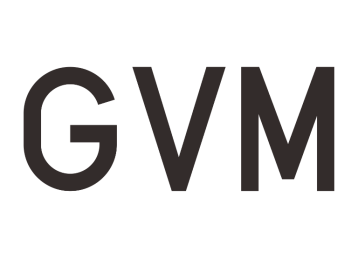
Report by Ron Johanson ACS OBE
The IMAGO Oslo Digital Cinema Conference took place in Oslo, Norway under the auspices of the Norwegian Society of Cinematographers and the guidance of IMAGO President, Paul Rene Roestad FNF on the 8th, 9th and 10th September at the Norwegian Film Institute and Cinematek in Central Oslo. This particular event was one that I believe the Society can also implement in the future, as it requires minimal set up time as long as the venue and of course funding can be found, as the whole running of the event does centre around the most practical venue.
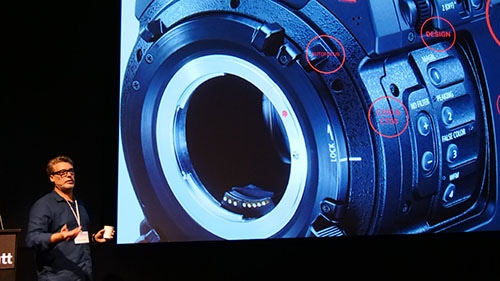 The IMAGO Oslo Digital Cinema Conference began with a presentation from London based NSW Branch member, Brett Danton who spoke glowingly about the new Canon C700 and the advantages he found with RAW workflow on a recent TVC for Jaguar shot here in Australia. Brett has agreed to share this presentation with us when he returns Australia in November. I must say that the screen at the NFI was superb and all images were screened at optimum quality for all to see, particularly relevant given IMAGO and the Committee for Creative Technologies are in discussion regarding establishing a grading “Star System” for all cinema screens, at this stage in Europe, but the future does hold promise for our region as well.
The IMAGO Oslo Digital Cinema Conference began with a presentation from London based NSW Branch member, Brett Danton who spoke glowingly about the new Canon C700 and the advantages he found with RAW workflow on a recent TVC for Jaguar shot here in Australia. Brett has agreed to share this presentation with us when he returns Australia in November. I must say that the screen at the NFI was superb and all images were screened at optimum quality for all to see, particularly relevant given IMAGO and the Committee for Creative Technologies are in discussion regarding establishing a grading “Star System” for all cinema screens, at this stage in Europe, but the future does hold promise for our region as well.
NEXT GENERATION IMAGING AND THE IMPACT OF HDR – David Stump ASC
David Stump ASC has in his presentation called for the attention of using HDR capture format. The artefacts will be a lot more visible due to the highest level of sharpness. Panning speeds as well are a manner of being careful due to double «exposure» in the HDR domain causing artifacts in the image on the edges. Read HERE Davis Stump’s full power point presented at the Conference.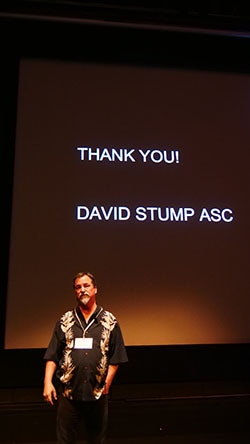
35mm, 5000ISO HIGH SPEED SENSORS
Cinematographer Matthias Bolliger spoke enthusiastically about the Panasonic Varicam and the added positive impact it brought to his low light work with the high speed sensor. There is more here at this link:
http://info.panasonic.com/varicam-properties.html
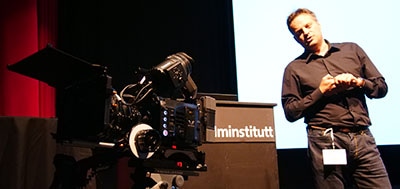 ACES- EXPERIENCES, NEW DEVELOPMENTS & THE FUTURE –
ACES- EXPERIENCES, NEW DEVELOPMENTS & THE FUTURE –
Alex Forsyth flew from Los Angeles and gave an insightful presentation on ACES.
So, What is ACES? ACES (Academy Color Encoding Systems) is a series of guidelines and specifications for every type of color management, from image capture to post-production to distribution. ACES is a free and open color management system, meaning it is not tied to a specific platform or program. It’s designed to work with the technology of today, as well as future workflows.
The ACES color space includes everything the human eye can see, meaning there are no restrictions or limitations of the color space. It is not a program or workflow or “look.” ACES was designed to help you with your workflow. ACES consists of encoding specifications, transform definitions and guidelines, metadata definitions, standard screen specifications, and the specifications for archive-ready image data and metadata.
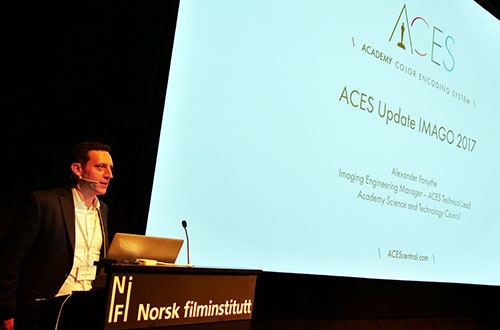 Adopting ACES – ACES is becoming popular among large scale blockbuster films, especially those that tend to be CG/VFX heavy. The growing list of films using ACES include:
Adopting ACES – ACES is becoming popular among large scale blockbuster films, especially those that tend to be CG/VFX heavy. The growing list of films using ACES include:
Chappie, The Lego Movie, Oblivion, and Guardians of the Galaxy Vol.2.
If you want to consider adopting ACES standards in your productions, you can dive into all the technical writings on ACES by visiting the ACES Documentation page. Additionally, you can find other support and resources at ACES Central, the dedicated hub and forum for all things related to ACES colour encoding. MORE by clicking link or image.
MORE Info click this link » https://vimeo.com/125850550
LUCIANO TOVOLI AIC ASC – The highlight of the day was the screening of the Antonioni film Professione: Reporter and the ensuing Q&A with the “maestro” Luciano Tovoli AIC ASC. One cannot help but be captivated listening to Luciano talk with great reverence about Michelangelo Antonioni along with most Directors he collaborates with. Of particular interest in this film and explored in detail by moderator Kjell Runar Jensen from the Norwegian society, was the amazing one shot scene which features Jack Nicholson lying on a bed, looking out to a courtyard and the camera moving slowly
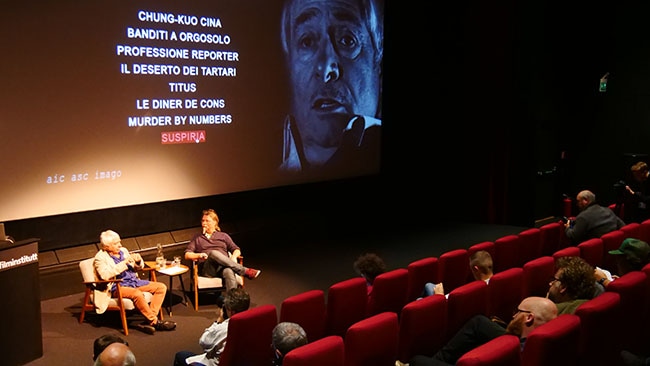 across the room, through the bars of the window into the courtyard to capture a scene involving the arrival of a car and a beautiful woman, the camera follows her into the building, rotating 180 degrees and then settling, looking through the bars from outside as she enters the room with the police to see the body on the bed. In effect a 360 degree shot, which was truly outstanding given the technology of the day. Must see – Professione: Reporter!
across the room, through the bars of the window into the courtyard to capture a scene involving the arrival of a car and a beautiful woman, the camera follows her into the building, rotating 180 degrees and then settling, looking through the bars from outside as she enters the room with the police to see the body on the bed. In effect a 360 degree shot, which was truly outstanding given the technology of the day. Must see – Professione: Reporter!
One of the most interesting sessions for me was the one dealing with CINEMATOGRAPHERS AUTHORS RIGHTS – This was a case study from Norway by Bjorn Alexander Brem from the Norwegian Filmmakers Association, who spoke with great knowledge about this rather vexing issue for us here in the Southern hemisphere, although he did point out not all was perfect in the Scandinavian system, but it was in reasonable shape compared to most, who like us, have nothing to speak of. I have included his presentation and welcome any questions you may have.
ODCC Talk Direct Injection FNF – Download the PDF HERE »
I can tell you that this issue of Authors Rights for cinematographers will be discussed by IMAGO in Helsinki with the potential to seeing if this can become a global initiative of IMAGO.
Philippe Ros AFC, Rolf Coulanges BVK and Mick Van Rossum NSC from the IMAGO Committee for Creative Technologies collaborated to bring a presentation dealing with:  TEXTURE CONTROL IN THE WORKFLOW. This was a fairly technical presentation but the overall take out was the control of the final image, which is a subject close to all our hearts. Philippe, Rolf and Mick are three extraordinarily talented cinematographers who also possess a real solid technical understanding of those areas that tend to get us mere mortals into trouble.
TEXTURE CONTROL IN THE WORKFLOW. This was a fairly technical presentation but the overall take out was the control of the final image, which is a subject close to all our hearts. Philippe, Rolf and Mick are three extraordinarily talented cinematographers who also possess a real solid technical understanding of those areas that tend to get us mere mortals into trouble.
I have included Philippe’s presentation which I hope will help explain it with more clarity. ODCC_2017_TEXTURE_2_PRESENTATION.pdf »
Norwegian filmmaker ~ Janike Mikkelsen
VIRTUAL REALITY 3D: Case Study – The Champions ~ Norwegian filmmaker, Ms Janike Mikkelsen presented a fantastic overview of her groundbreaking work on The Queen Concert film – The Champions. She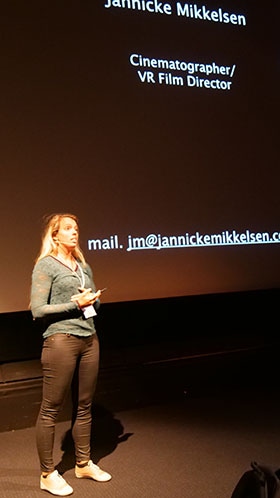 related the story about being contacted by astro physicist Dr Brian May who just happens to be the lead guitarist of Queen who had heard of her extraordinary ability as a stereographer and asked if she would be interested in producing a film based on their next concert. This was a project for the fans and initially was only one song, The Champions, but eventually it became the whole concert, which was another story altogether.
related the story about being contacted by astro physicist Dr Brian May who just happens to be the lead guitarist of Queen who had heard of her extraordinary ability as a stereographer and asked if she would be interested in producing a film based on their next concert. This was a project for the fans and initially was only one song, The Champions, but eventually it became the whole concert, which was another story altogether.
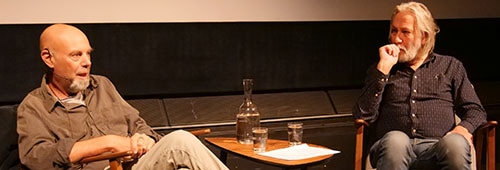 LUCA BIGAZZI is an acclaimed Italian cinematographer who with his quiet reserved approach to visual storytelling has received seven David di Donatello Awards for Best Cinematography. He has worked with directors such as Silvio Soldini, Mario Martone, Felice Farina, Gianni Amelio, Francesca Archibugi, and Paolo Sorrentino, one of Italy’s most revered Directors, nominated six times for the Palme d’Or. I have been a huge fan of Luca’s work for sometime and his most recent work on The Young Pope was a tour de force. His work with director Sorrentino features virtuosic camera movements but his architectural framing, and the way his lenses create the actors space to move, showcases the use of the frame that are a feature of all his work as a cinematographer. Luca Bigazzi stands right alongside the other great Italian cinematographers at the very top of his game, and to hear him speak with such clarity and subdued passion about his role as a cinematographer is something not to be missed.
LUCA BIGAZZI is an acclaimed Italian cinematographer who with his quiet reserved approach to visual storytelling has received seven David di Donatello Awards for Best Cinematography. He has worked with directors such as Silvio Soldini, Mario Martone, Felice Farina, Gianni Amelio, Francesca Archibugi, and Paolo Sorrentino, one of Italy’s most revered Directors, nominated six times for the Palme d’Or. I have been a huge fan of Luca’s work for sometime and his most recent work on The Young Pope was a tour de force. His work with director Sorrentino features virtuosic camera movements but his architectural framing, and the way his lenses create the actors space to move, showcases the use of the frame that are a feature of all his work as a cinematographer. Luca Bigazzi stands right alongside the other great Italian cinematographers at the very top of his game, and to hear him speak with such clarity and subdued passion about his role as a cinematographer is something not to be missed.
READ the link: ‘The Young Pope’ DP Luca Bigazzi Gives A Window Into A Collaboration “Made Up Of Few Words And Mutual Understanding” »
IMAGO REQUESTS TO MANUFACTURERS
The last session of the Conference was one delivered by Philippe Ros AFC, Rolf Coulanges BVK and Mick Van Rossum NSC from the IMAGO Committee for Creative Technologies. The basic idea was that Cinematographers (IMAGO in cooperation with other Societies) should work to obtain greater influence over the cameras, software and equipment that we use. A complex issue that requires considerable collaboration, but certainly a step in the right direction.
This would essentially involve Cinematographers working and collaborating with manufacturers more than we currently do to “tailor make” equipment to specifications. This is a big and important step and requires IMAGO to get consensus and backing as to what to prioritize amongst as many Societies as possible, thereby we will have a greater possibility to succeed. This, I am sure you agree is a great starting point, with a great deal of work to be done before the collaboration can begin.
AUTHORS OR DIRECTORS OF CINEMATOGRAPHY? At the ASC Summit in Los Angeles, Vittorio Storaro AIC ASC spoke about the notion to adopt the screen credit as Author of Cinematography which is opposed to Director of Photography. There are many who believe the latter is an outdated title as in the literal sense we are cinematographers NOT photographers. Semantics perhaps, but I also feel it is time we considered a change, but I favour Director of Cinematography.
CHECK PHOTO GALLERY FACEBOOK











